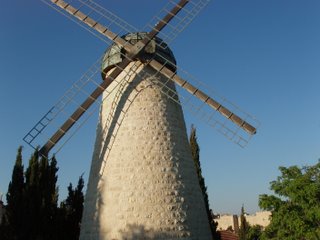
We had dinner with several friends at the Paradiso restaurant in Jerusalem last night. The restaurant is across a major intersection from the windmill at Yemen Moshe. Before dinner, we had time to walk through the picturesque streets of Yemen Moshe, cross the garden area in front of the Old City Wall, climb the hill, and enter briefy into the Jaffa Gate area of the Old City.
Yemen Moshe is just outside the walls of the city. Built by pioneering Jews, it was a daring place to live in the nineteenth century. The neighborhood was on the dividing line between Israeli and Jordanian-held Jerusalem until 1967, and thus vacant. Houses had to undergo major rennovation after the 6-Day War.
All the houses, walls, pedestrian streets, and stairways in Yemen Moshe are made of the beautiful sand-colored Jerusalem stone. Residents park in lots on the periphery of the neighborhood, so the area has a strangely quiet and almost deserted atmosphere. Flowers bloom everywhere, and all of the stone surfaces are perfectly clean. During our walk, the setting sun gave a increasingly pinkish glow to the stones.
Although called "Italian" Paradiso actually offers several Romanian dishes and Israeli kabobs, as well as pasta. I had a very nice grilled steak with wine sauce, and Romanian sour soup with meatballs and chicken. We drank wine from the Upper Galilee, which was very good. We all enjoyed the food, and we had a very animated conversation about many current topics, including the recent controversial statements from A.B.Yehoshua (see my post "A Dialog of the Deaf" on this issue) and rumors of the fall of the dollar.
1 comment:
Yemen Moshe is just outside the walls of the city. Built by pioneering Jews, it was a daring place to live in the nineteenth century.
The actual history of how Jews came to move out of the grossly overcrowded Jewish Quater inside the Old City walls and into Yemin Moshe is a fascinating one:
In 1860, Moshe Montifiori recognized the need to move Jews into new settlements. He commissioned the first compound in Yemin Moshe. Because he knew the Jews of the Old City feared the wild animals and robbers that combed the hills around Jerusalem, he had the building designed to resemble a wall. Still the Jews refused to move. He offerred the apartments for fee -- no Jews. He offered to pay people to move. Some came -- but these "brave" folks didn't give up their homes inside the city walls. They'd sleep there at night and hurry back to Yemin Moshe in the early morning before Montifiore's inspector would arrive. [The inspector himself refused to live in the compound.]
In 1866 there was a cholera outbreak in Jerusalem. Miracle or miracles, the people in Yemin Moshe didn't get sick. [They had proper sewage.] Finally, a number of Jews agreed to move in!
Post a Comment